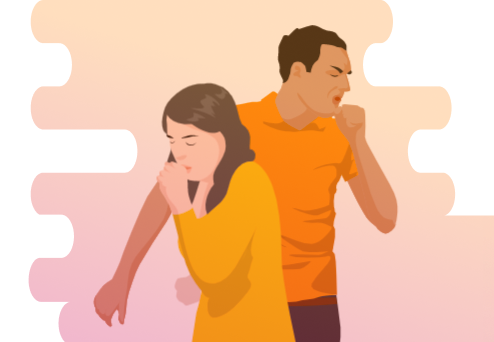The investigation of viruses and their relations with living organisms is a complicated and quickly expanding area, and much remains to be discovered about the complexity and behavior of these small but potent agents of illness and evolution.
It’s important to note that not all viruses are dangerous to people or other living organisms, however, there are several viruses that can impair human health, one of which being Norovirus, the main topic of this article, sometimes referred to as the winter vomiting bug.
Thankfully, we are well-informed about norovirus, but there is still a lot to learn. Norovirus was discovered in 1972, and considerable investigation has been undertaken since then to better understand its behavior and traits.
What is norovirus and is it spread?
If you’re curious to know what is norovirus, the first thing you should know is that norovirus is a highly contagious disease. Norovirus infection can cause extreme vomiting and diarrhea that appears at random. Norovirus is one of the most prevalent causes of gastroenteritis globally, causing a large amount of foodborne sickness.
Norovirus is easily transmitted by contaminated food or water; food can get contaminated at any stage of manufacturing, processing, or preparation, whereas water can become infected owing to water supply difficulties or poor sanitation. The virus can also be spread by contact with infected surfaces and then touching the mouth, nose or eyes, or close contact with an infected person.
Although norovirus may affect individuals of all ages, it is more prevalent in children for a range of reasons. Children are possibly more prone to norovirus because their immune systems are less developed, making it more challenging for their bodies to fight diseases. Furthermore, children frequently come into closer proximity with other children in settings such as schools and childcare facilities, which might raise the risk of viral infection.
What are the symptoms of norovirus?
The norovirus causes stomach and intestinal irritation. Symptoms of norovirus generally occur 12 to 48 hours after virus infection and may include:
- Nausea and vomiting;
- Weakness and tiredness;
- Watery diarrhea;
- Low-severity fever;
- Body aching;
- Cramps and belly discomfort;
- Headache.
Symptoms typically last one to three days, and the majority of individuals recover without difficulties. Dehydration, on the other hand, can arise in severe situations, particularly in small children, elderly persons, and those with weaker immune systems.
According to the Centers for Disease Control and Prevention (CDC), norovirus kills between 570 and 800 people in the United States each year, with the elderly causing the majority of the number of casualties. Overall, while norovirus can cause severe pain and, in rare circumstances, serious complications, it is not usually fatal in otherwise healthy people.
The standard treatment includes drinking plenty of fluids, resting, and avoiding solid foods, sticking to easy-to-digest foods.
How to prevent norovirus infections?
Now that you understand what is norovirus, it is critical to consider prevention measures.
- Avoid direct contact with sick people;
- Wash your hands with soap and water regularly and thoroughly, especially after using the restroom, changing diapers, or before preparing food or eating;
- Shellfish should be completely cooked before eating. Norovirus can live in raw or undercooked seafood;
- If you have norovirus symptoms, avoid preparing meals for others;
- If you are unwell, stay at home to avoid spreading the infection to others;
- Maintain excellent hygiene by not touching your face and by covering your mouth and nose while coughing or sneezing;
- Surfaces that may have come into touch with norovirus, such as worktops, doorknobs, and bathroom fixtures, should be cleaned and disinfected.
Why is it called “the winter vomiting bug”?
Norovirus is popularly known as “the winter vomiting bug” since it is more frequent during the winter months and one of its major symptoms is vomiting.
People spend more time inside, in closer interaction with others, and in more congested situations throughout the winter. This can enhance the chance of norovirus transmission through exposure to contaminated surfaces, food, or water, as well as contact with sick people.
Furthermore, norovirus is more stable at colder temperatures, allowing it to live on surfaces and in the environment for extended periods of time throughout the winter months.
Stomach bug vs. Norovirus
The expression “stomach bug” refers to any sickness that causes symptoms like nausea, vomiting, diarrhea, and abdominal cramps.
While norovirus is one of the most prevalent causes of stomach bugs, several other viruses and bacteria can produce similar symptoms, for example, the bacterias Salmonella, Campylobacter, and E. coli, as well as viruses such as rotavirus and adenovirus.
It might be difficult to differentiate between different causes of stomach bugs based just on symptoms, however, if you find yourself experiencing any symptoms of a stomach bug, it’s important to follow the preventative measures, as well as drinking lots of fluids and resting.
Online infographic maker for science
Scientists can use infographics to better convey their research, they can capture the attention of a larger audience, including the non-science community, by presenting their findings in an infographic format, raising awareness about a specific topic, or advocating for the value of scientific research.
Mind The Graph has developed the ideal tool to effortlessly create infographics and illustrations, as easily as you can imagine them, to honor the essential work of scientists.

Subscribe to our newsletter
Exclusive high quality content about effective visual
communication in science.





